Global Mining Corporation Expansion Project Report: SOE11144
VerifiedAdded on 2023/06/04
|14
|3613
|116
Report
AI Summary
This report evaluates a multinational mining corporation's expansion plan, commissioned by a regional division as a management consultant. The report assesses the feasibility of expanding operations, considering potential risks related to cost and price fluctuations. It employs investment appraisal techniques, including Net Present Value (NPV), Internal Rate of Return (IRR), Payback Period, and Discounted Payback Period, to analyze the project's financial viability. The evaluation includes detailed cash flow analysis over a 10-year period, determining the reasonableness of the target rate of return and the suitability of performance targets for mining operations. The analysis highlights the project's positive attributes, supporting the recommendation to proceed with the expansion. The report provides an executive summary, introduction, methodology, evaluation, discussion, conclusions, and recommendations, along with references and bibliography, to provide a comprehensive assessment for the regional director and the board of directors.
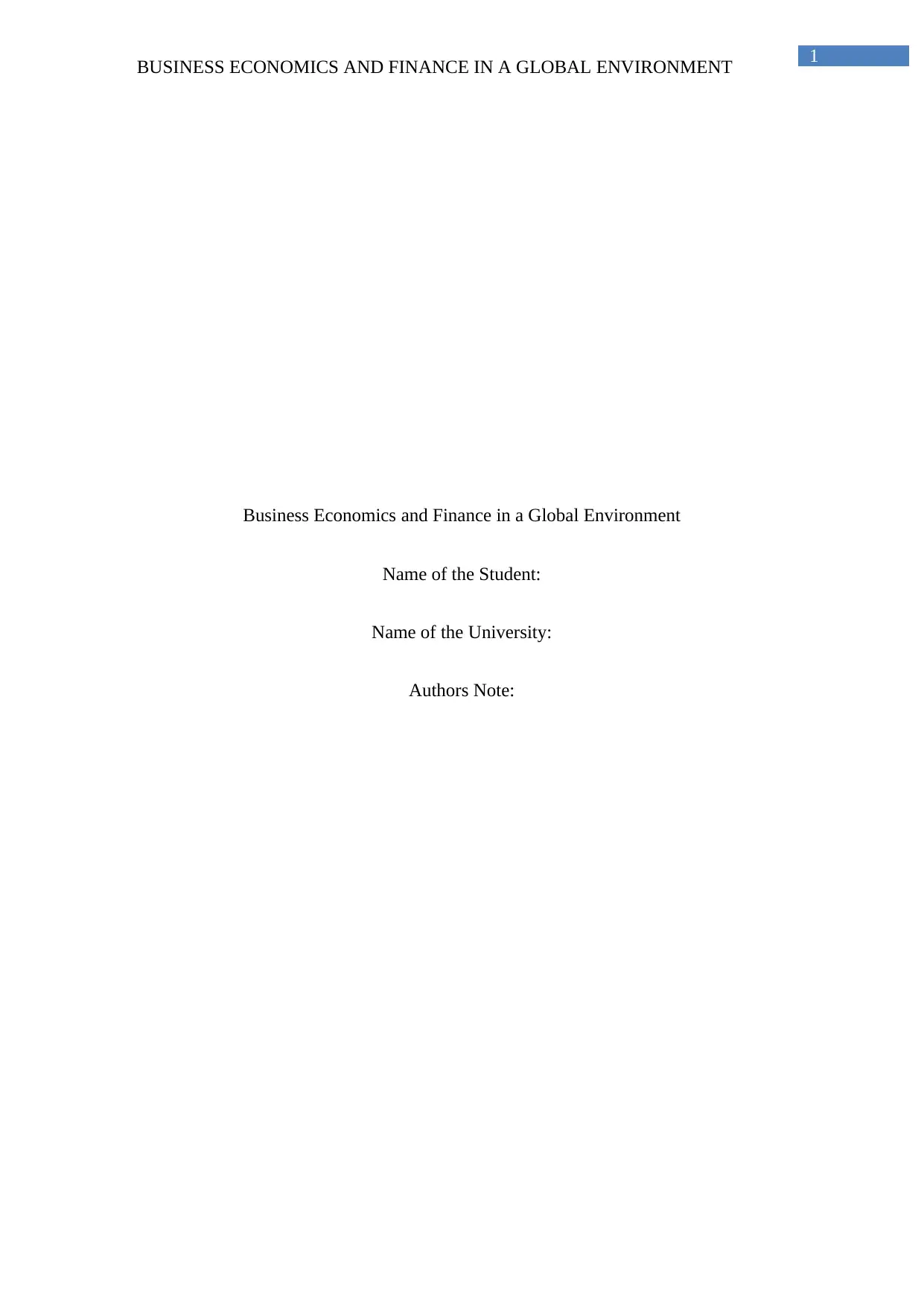
BUSINESS ECONOMICS AND FINANCE IN A GLOBAL ENVIRONMENT 1
Business Economics and Finance in a Global Environment
Name of the Student:
Name of the University:
Authors Note:
Business Economics and Finance in a Global Environment
Name of the Student:
Name of the University:
Authors Note:
Paraphrase This Document
Need a fresh take? Get an instant paraphrase of this document with our AI Paraphraser
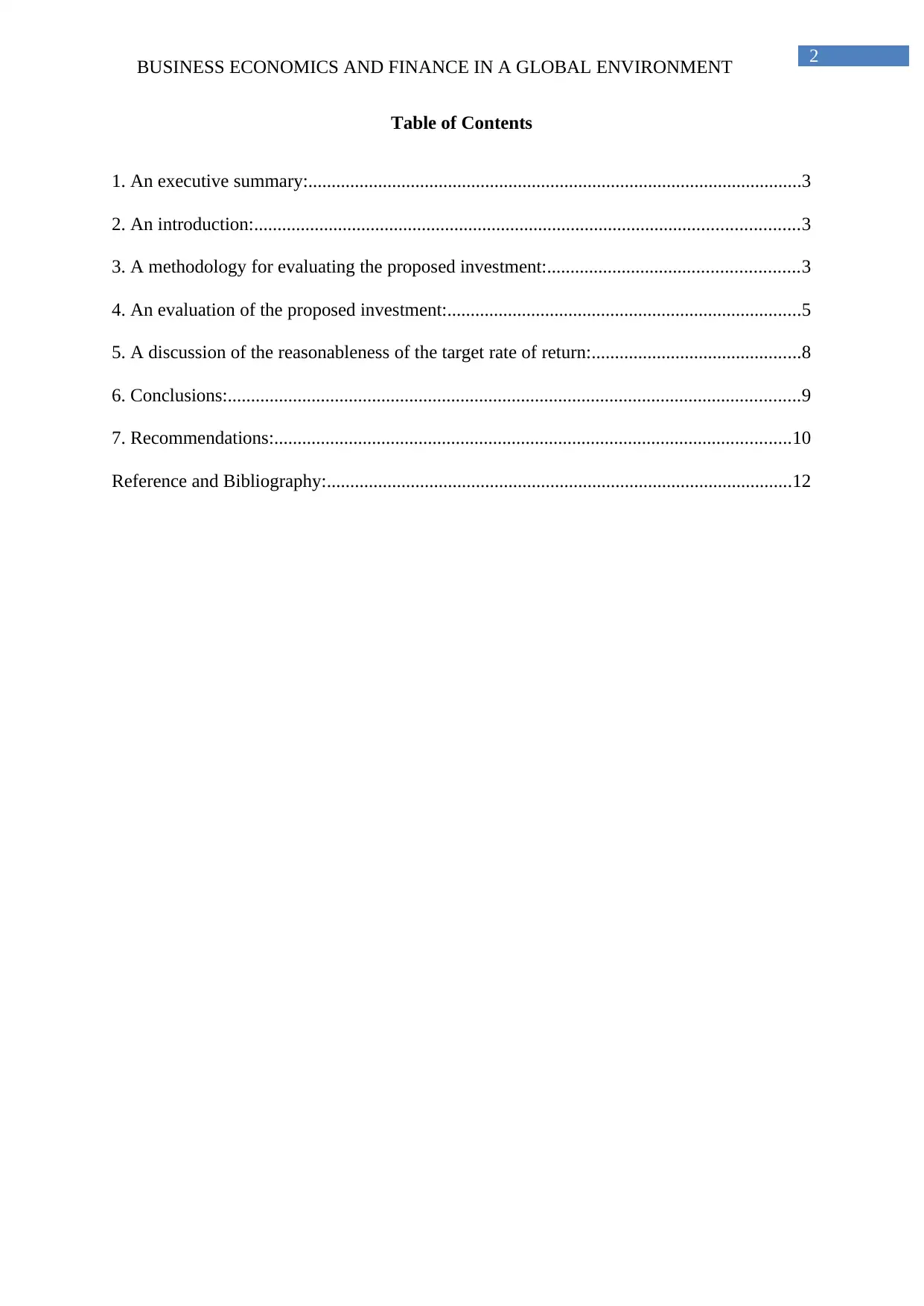
BUSINESS ECONOMICS AND FINANCE IN A GLOBAL ENVIRONMENT 2
Table of Contents
1. An executive summary:..........................................................................................................3
2. An introduction:.....................................................................................................................3
3. A methodology for evaluating the proposed investment:......................................................3
4. An evaluation of the proposed investment:............................................................................5
5. A discussion of the reasonableness of the target rate of return:.............................................8
6. Conclusions:...........................................................................................................................9
7. Recommendations:...............................................................................................................10
Reference and Bibliography:....................................................................................................12
Table of Contents
1. An executive summary:..........................................................................................................3
2. An introduction:.....................................................................................................................3
3. A methodology for evaluating the proposed investment:......................................................3
4. An evaluation of the proposed investment:............................................................................5
5. A discussion of the reasonableness of the target rate of return:.............................................8
6. Conclusions:...........................................................................................................................9
7. Recommendations:...............................................................................................................10
Reference and Bibliography:....................................................................................................12
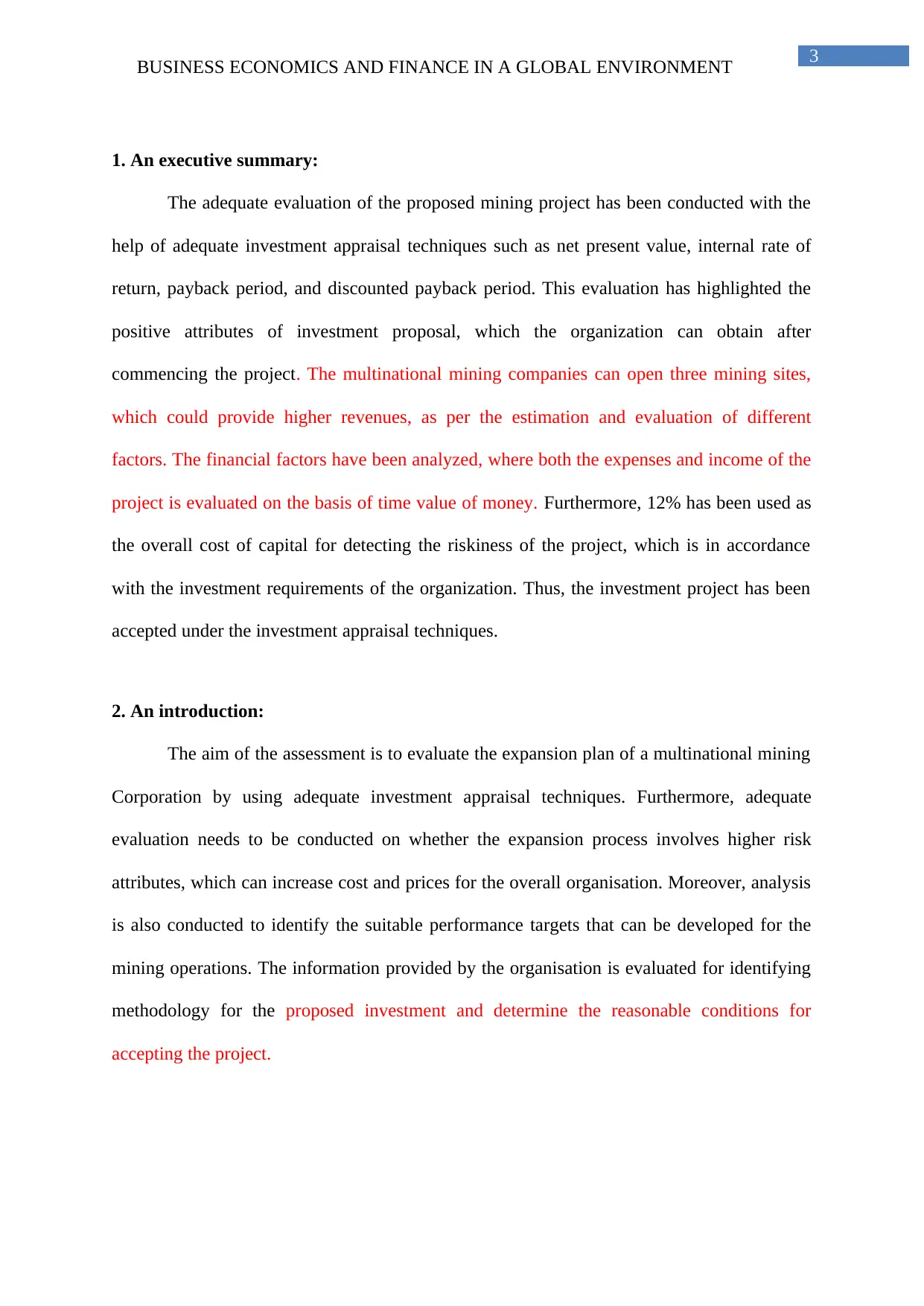
BUSINESS ECONOMICS AND FINANCE IN A GLOBAL ENVIRONMENT 3
1. An executive summary:
The adequate evaluation of the proposed mining project has been conducted with the
help of adequate investment appraisal techniques such as net present value, internal rate of
return, payback period, and discounted payback period. This evaluation has highlighted the
positive attributes of investment proposal, which the organization can obtain after
commencing the project. The multinational mining companies can open three mining sites,
which could provide higher revenues, as per the estimation and evaluation of different
factors. The financial factors have been analyzed, where both the expenses and income of the
project is evaluated on the basis of time value of money. Furthermore, 12% has been used as
the overall cost of capital for detecting the riskiness of the project, which is in accordance
with the investment requirements of the organization. Thus, the investment project has been
accepted under the investment appraisal techniques.
2. An introduction:
The aim of the assessment is to evaluate the expansion plan of a multinational mining
Corporation by using adequate investment appraisal techniques. Furthermore, adequate
evaluation needs to be conducted on whether the expansion process involves higher risk
attributes, which can increase cost and prices for the overall organisation. Moreover, analysis
is also conducted to identify the suitable performance targets that can be developed for the
mining operations. The information provided by the organisation is evaluated for identifying
methodology for the proposed investment and determine the reasonable conditions for
accepting the project.
1. An executive summary:
The adequate evaluation of the proposed mining project has been conducted with the
help of adequate investment appraisal techniques such as net present value, internal rate of
return, payback period, and discounted payback period. This evaluation has highlighted the
positive attributes of investment proposal, which the organization can obtain after
commencing the project. The multinational mining companies can open three mining sites,
which could provide higher revenues, as per the estimation and evaluation of different
factors. The financial factors have been analyzed, where both the expenses and income of the
project is evaluated on the basis of time value of money. Furthermore, 12% has been used as
the overall cost of capital for detecting the riskiness of the project, which is in accordance
with the investment requirements of the organization. Thus, the investment project has been
accepted under the investment appraisal techniques.
2. An introduction:
The aim of the assessment is to evaluate the expansion plan of a multinational mining
Corporation by using adequate investment appraisal techniques. Furthermore, adequate
evaluation needs to be conducted on whether the expansion process involves higher risk
attributes, which can increase cost and prices for the overall organisation. Moreover, analysis
is also conducted to identify the suitable performance targets that can be developed for the
mining operations. The information provided by the organisation is evaluated for identifying
methodology for the proposed investment and determine the reasonable conditions for
accepting the project.
⊘ This is a preview!⊘
Do you want full access?
Subscribe today to unlock all pages.

Trusted by 1+ million students worldwide
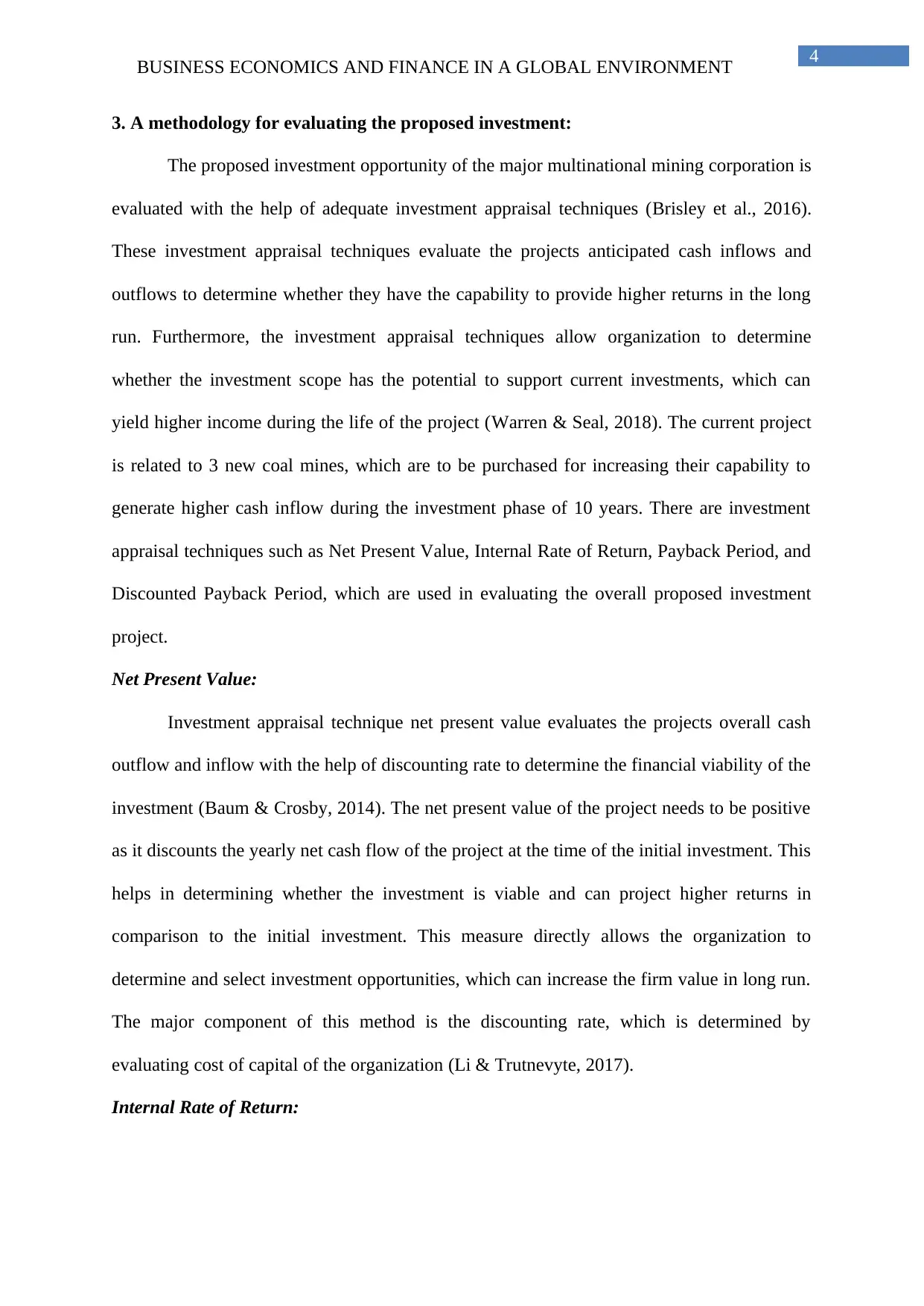
BUSINESS ECONOMICS AND FINANCE IN A GLOBAL ENVIRONMENT 4
3. A methodology for evaluating the proposed investment:
The proposed investment opportunity of the major multinational mining corporation is
evaluated with the help of adequate investment appraisal techniques (Brisley et al., 2016).
These investment appraisal techniques evaluate the projects anticipated cash inflows and
outflows to determine whether they have the capability to provide higher returns in the long
run. Furthermore, the investment appraisal techniques allow organization to determine
whether the investment scope has the potential to support current investments, which can
yield higher income during the life of the project (Warren & Seal, 2018). The current project
is related to 3 new coal mines, which are to be purchased for increasing their capability to
generate higher cash inflow during the investment phase of 10 years. There are investment
appraisal techniques such as Net Present Value, Internal Rate of Return, Payback Period, and
Discounted Payback Period, which are used in evaluating the overall proposed investment
project.
Net Present Value:
Investment appraisal technique net present value evaluates the projects overall cash
outflow and inflow with the help of discounting rate to determine the financial viability of the
investment (Baum & Crosby, 2014). The net present value of the project needs to be positive
as it discounts the yearly net cash flow of the project at the time of the initial investment. This
helps in determining whether the investment is viable and can project higher returns in
comparison to the initial investment. This measure directly allows the organization to
determine and select investment opportunities, which can increase the firm value in long run.
The major component of this method is the discounting rate, which is determined by
evaluating cost of capital of the organization (Li & Trutnevyte, 2017).
Internal Rate of Return:
3. A methodology for evaluating the proposed investment:
The proposed investment opportunity of the major multinational mining corporation is
evaluated with the help of adequate investment appraisal techniques (Brisley et al., 2016).
These investment appraisal techniques evaluate the projects anticipated cash inflows and
outflows to determine whether they have the capability to provide higher returns in the long
run. Furthermore, the investment appraisal techniques allow organization to determine
whether the investment scope has the potential to support current investments, which can
yield higher income during the life of the project (Warren & Seal, 2018). The current project
is related to 3 new coal mines, which are to be purchased for increasing their capability to
generate higher cash inflow during the investment phase of 10 years. There are investment
appraisal techniques such as Net Present Value, Internal Rate of Return, Payback Period, and
Discounted Payback Period, which are used in evaluating the overall proposed investment
project.
Net Present Value:
Investment appraisal technique net present value evaluates the projects overall cash
outflow and inflow with the help of discounting rate to determine the financial viability of the
investment (Baum & Crosby, 2014). The net present value of the project needs to be positive
as it discounts the yearly net cash flow of the project at the time of the initial investment. This
helps in determining whether the investment is viable and can project higher returns in
comparison to the initial investment. This measure directly allows the organization to
determine and select investment opportunities, which can increase the firm value in long run.
The major component of this method is the discounting rate, which is determined by
evaluating cost of capital of the organization (Li & Trutnevyte, 2017).
Internal Rate of Return:
Paraphrase This Document
Need a fresh take? Get an instant paraphrase of this document with our AI Paraphraser
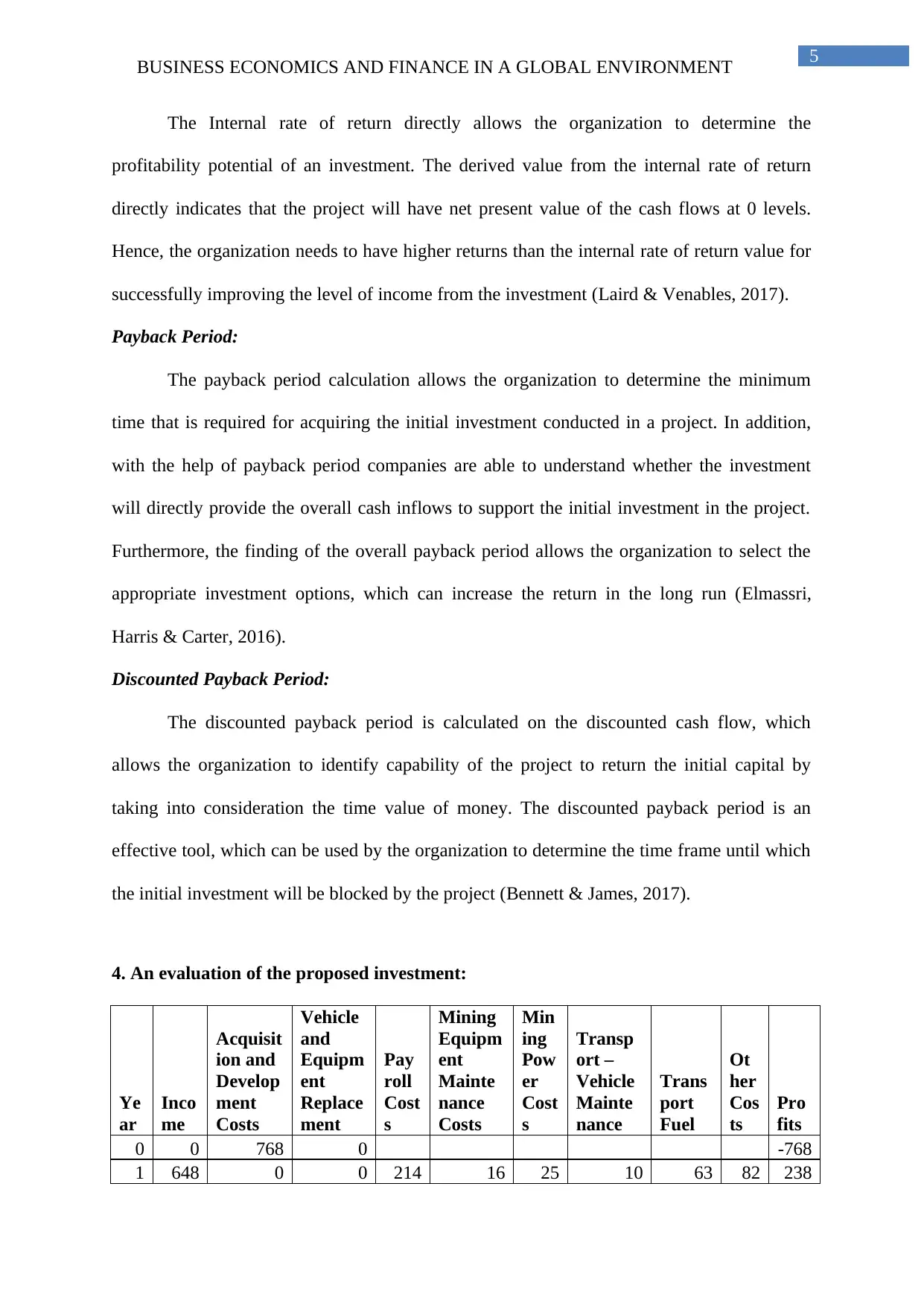
BUSINESS ECONOMICS AND FINANCE IN A GLOBAL ENVIRONMENT 5
The Internal rate of return directly allows the organization to determine the
profitability potential of an investment. The derived value from the internal rate of return
directly indicates that the project will have net present value of the cash flows at 0 levels.
Hence, the organization needs to have higher returns than the internal rate of return value for
successfully improving the level of income from the investment (Laird & Venables, 2017).
Payback Period:
The payback period calculation allows the organization to determine the minimum
time that is required for acquiring the initial investment conducted in a project. In addition,
with the help of payback period companies are able to understand whether the investment
will directly provide the overall cash inflows to support the initial investment in the project.
Furthermore, the finding of the overall payback period allows the organization to select the
appropriate investment options, which can increase the return in the long run (Elmassri,
Harris & Carter, 2016).
Discounted Payback Period:
The discounted payback period is calculated on the discounted cash flow, which
allows the organization to identify capability of the project to return the initial capital by
taking into consideration the time value of money. The discounted payback period is an
effective tool, which can be used by the organization to determine the time frame until which
the initial investment will be blocked by the project (Bennett & James, 2017).
4. An evaluation of the proposed investment:
Ye
ar
Inco
me
Acquisit
ion and
Develop
ment
Costs
Vehicle
and
Equipm
ent
Replace
ment
Pay
roll
Cost
s
Mining
Equipm
ent
Mainte
nance
Costs
Min
ing
Pow
er
Cost
s
Transp
ort –
Vehicle
Mainte
nance
Trans
port
Fuel
Ot
her
Cos
ts
Pro
fits
0 0 768 0 -768
1 648 0 0 214 16 25 10 63 82 238
The Internal rate of return directly allows the organization to determine the
profitability potential of an investment. The derived value from the internal rate of return
directly indicates that the project will have net present value of the cash flows at 0 levels.
Hence, the organization needs to have higher returns than the internal rate of return value for
successfully improving the level of income from the investment (Laird & Venables, 2017).
Payback Period:
The payback period calculation allows the organization to determine the minimum
time that is required for acquiring the initial investment conducted in a project. In addition,
with the help of payback period companies are able to understand whether the investment
will directly provide the overall cash inflows to support the initial investment in the project.
Furthermore, the finding of the overall payback period allows the organization to select the
appropriate investment options, which can increase the return in the long run (Elmassri,
Harris & Carter, 2016).
Discounted Payback Period:
The discounted payback period is calculated on the discounted cash flow, which
allows the organization to identify capability of the project to return the initial capital by
taking into consideration the time value of money. The discounted payback period is an
effective tool, which can be used by the organization to determine the time frame until which
the initial investment will be blocked by the project (Bennett & James, 2017).
4. An evaluation of the proposed investment:
Ye
ar
Inco
me
Acquisit
ion and
Develop
ment
Costs
Vehicle
and
Equipm
ent
Replace
ment
Pay
roll
Cost
s
Mining
Equipm
ent
Mainte
nance
Costs
Min
ing
Pow
er
Cost
s
Transp
ort –
Vehicle
Mainte
nance
Trans
port
Fuel
Ot
her
Cos
ts
Pro
fits
0 0 768 0 -768
1 648 0 0 214 16 25 10 63 82 238
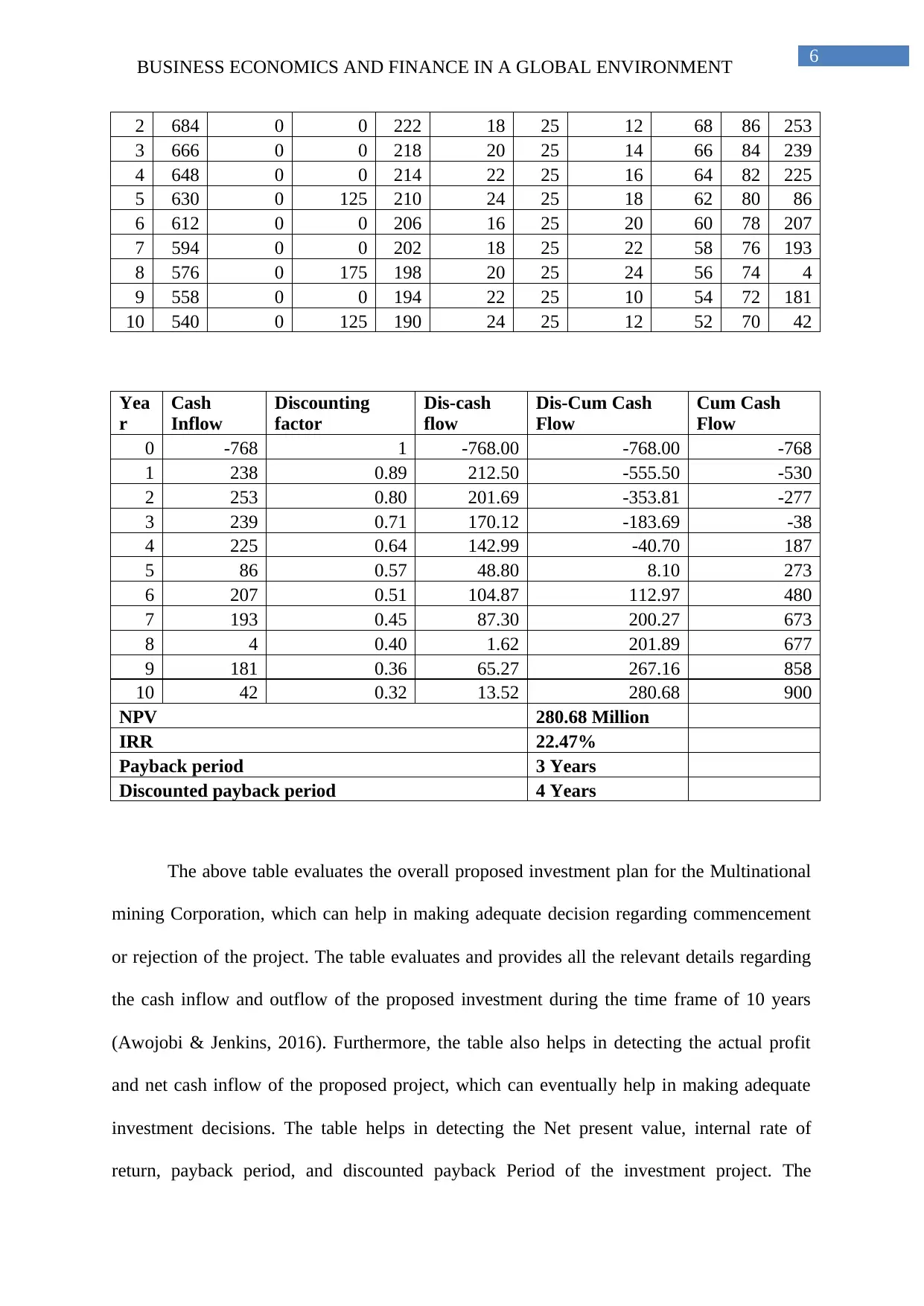
BUSINESS ECONOMICS AND FINANCE IN A GLOBAL ENVIRONMENT 6
2 684 0 0 222 18 25 12 68 86 253
3 666 0 0 218 20 25 14 66 84 239
4 648 0 0 214 22 25 16 64 82 225
5 630 0 125 210 24 25 18 62 80 86
6 612 0 0 206 16 25 20 60 78 207
7 594 0 0 202 18 25 22 58 76 193
8 576 0 175 198 20 25 24 56 74 4
9 558 0 0 194 22 25 10 54 72 181
10 540 0 125 190 24 25 12 52 70 42
Yea
r
Cash
Inflow
Discounting
factor
Dis-cash
flow
Dis-Cum Cash
Flow
Cum Cash
Flow
0 -768 1 -768.00 -768.00 -768
1 238 0.89 212.50 -555.50 -530
2 253 0.80 201.69 -353.81 -277
3 239 0.71 170.12 -183.69 -38
4 225 0.64 142.99 -40.70 187
5 86 0.57 48.80 8.10 273
6 207 0.51 104.87 112.97 480
7 193 0.45 87.30 200.27 673
8 4 0.40 1.62 201.89 677
9 181 0.36 65.27 267.16 858
10 42 0.32 13.52 280.68 900
NPV 280.68 Million
IRR 22.47%
Payback period 3 Years
Discounted payback period 4 Years
The above table evaluates the overall proposed investment plan for the Multinational
mining Corporation, which can help in making adequate decision regarding commencement
or rejection of the project. The table evaluates and provides all the relevant details regarding
the cash inflow and outflow of the proposed investment during the time frame of 10 years
(Awojobi & Jenkins, 2016). Furthermore, the table also helps in detecting the actual profit
and net cash inflow of the proposed project, which can eventually help in making adequate
investment decisions. The table helps in detecting the Net present value, internal rate of
return, payback period, and discounted payback Period of the investment project. The
2 684 0 0 222 18 25 12 68 86 253
3 666 0 0 218 20 25 14 66 84 239
4 648 0 0 214 22 25 16 64 82 225
5 630 0 125 210 24 25 18 62 80 86
6 612 0 0 206 16 25 20 60 78 207
7 594 0 0 202 18 25 22 58 76 193
8 576 0 175 198 20 25 24 56 74 4
9 558 0 0 194 22 25 10 54 72 181
10 540 0 125 190 24 25 12 52 70 42
Yea
r
Cash
Inflow
Discounting
factor
Dis-cash
flow
Dis-Cum Cash
Flow
Cum Cash
Flow
0 -768 1 -768.00 -768.00 -768
1 238 0.89 212.50 -555.50 -530
2 253 0.80 201.69 -353.81 -277
3 239 0.71 170.12 -183.69 -38
4 225 0.64 142.99 -40.70 187
5 86 0.57 48.80 8.10 273
6 207 0.51 104.87 112.97 480
7 193 0.45 87.30 200.27 673
8 4 0.40 1.62 201.89 677
9 181 0.36 65.27 267.16 858
10 42 0.32 13.52 280.68 900
NPV 280.68 Million
IRR 22.47%
Payback period 3 Years
Discounted payback period 4 Years
The above table evaluates the overall proposed investment plan for the Multinational
mining Corporation, which can help in making adequate decision regarding commencement
or rejection of the project. The table evaluates and provides all the relevant details regarding
the cash inflow and outflow of the proposed investment during the time frame of 10 years
(Awojobi & Jenkins, 2016). Furthermore, the table also helps in detecting the actual profit
and net cash inflow of the proposed project, which can eventually help in making adequate
investment decisions. The table helps in detecting the Net present value, internal rate of
return, payback period, and discounted payback Period of the investment project. The
⊘ This is a preview!⊘
Do you want full access?
Subscribe today to unlock all pages.

Trusted by 1+ million students worldwide
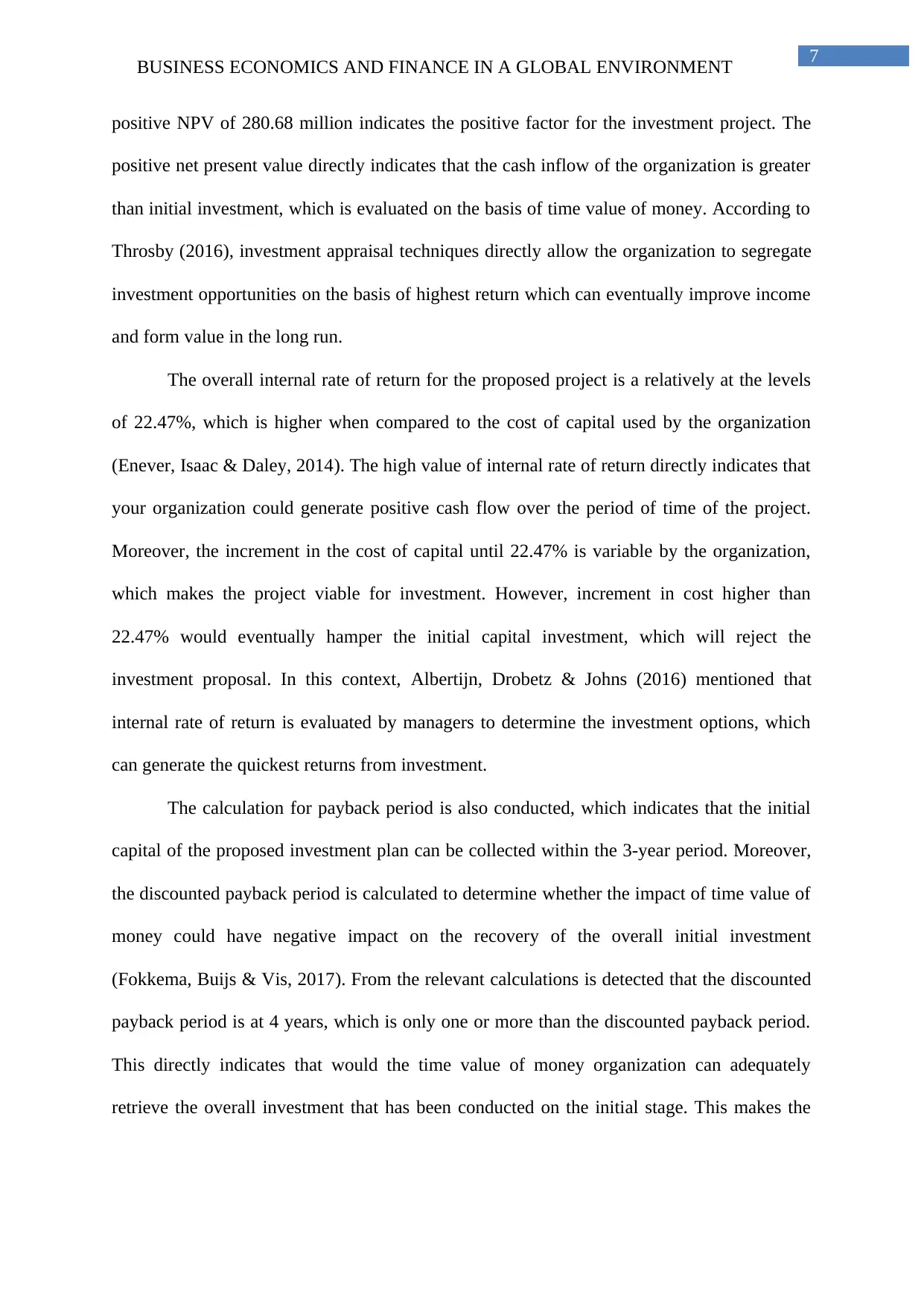
BUSINESS ECONOMICS AND FINANCE IN A GLOBAL ENVIRONMENT 7
positive NPV of 280.68 million indicates the positive factor for the investment project. The
positive net present value directly indicates that the cash inflow of the organization is greater
than initial investment, which is evaluated on the basis of time value of money. According to
Throsby (2016), investment appraisal techniques directly allow the organization to segregate
investment opportunities on the basis of highest return which can eventually improve income
and form value in the long run.
The overall internal rate of return for the proposed project is a relatively at the levels
of 22.47%, which is higher when compared to the cost of capital used by the organization
(Enever, Isaac & Daley, 2014). The high value of internal rate of return directly indicates that
your organization could generate positive cash flow over the period of time of the project.
Moreover, the increment in the cost of capital until 22.47% is variable by the organization,
which makes the project viable for investment. However, increment in cost higher than
22.47% would eventually hamper the initial capital investment, which will reject the
investment proposal. In this context, Albertijn, Drobetz & Johns (2016) mentioned that
internal rate of return is evaluated by managers to determine the investment options, which
can generate the quickest returns from investment.
The calculation for payback period is also conducted, which indicates that the initial
capital of the proposed investment plan can be collected within the 3-year period. Moreover,
the discounted payback period is calculated to determine whether the impact of time value of
money could have negative impact on the recovery of the overall initial investment
(Fokkema, Buijs & Vis, 2017). From the relevant calculations is detected that the discounted
payback period is at 4 years, which is only one or more than the discounted payback period.
This directly indicates that would the time value of money organization can adequately
retrieve the overall investment that has been conducted on the initial stage. This makes the
positive NPV of 280.68 million indicates the positive factor for the investment project. The
positive net present value directly indicates that the cash inflow of the organization is greater
than initial investment, which is evaluated on the basis of time value of money. According to
Throsby (2016), investment appraisal techniques directly allow the organization to segregate
investment opportunities on the basis of highest return which can eventually improve income
and form value in the long run.
The overall internal rate of return for the proposed project is a relatively at the levels
of 22.47%, which is higher when compared to the cost of capital used by the organization
(Enever, Isaac & Daley, 2014). The high value of internal rate of return directly indicates that
your organization could generate positive cash flow over the period of time of the project.
Moreover, the increment in the cost of capital until 22.47% is variable by the organization,
which makes the project viable for investment. However, increment in cost higher than
22.47% would eventually hamper the initial capital investment, which will reject the
investment proposal. In this context, Albertijn, Drobetz & Johns (2016) mentioned that
internal rate of return is evaluated by managers to determine the investment options, which
can generate the quickest returns from investment.
The calculation for payback period is also conducted, which indicates that the initial
capital of the proposed investment plan can be collected within the 3-year period. Moreover,
the discounted payback period is calculated to determine whether the impact of time value of
money could have negative impact on the recovery of the overall initial investment
(Fokkema, Buijs & Vis, 2017). From the relevant calculations is detected that the discounted
payback period is at 4 years, which is only one or more than the discounted payback period.
This directly indicates that would the time value of money organization can adequately
retrieve the overall investment that has been conducted on the initial stage. This makes the
Paraphrase This Document
Need a fresh take? Get an instant paraphrase of this document with our AI Paraphraser
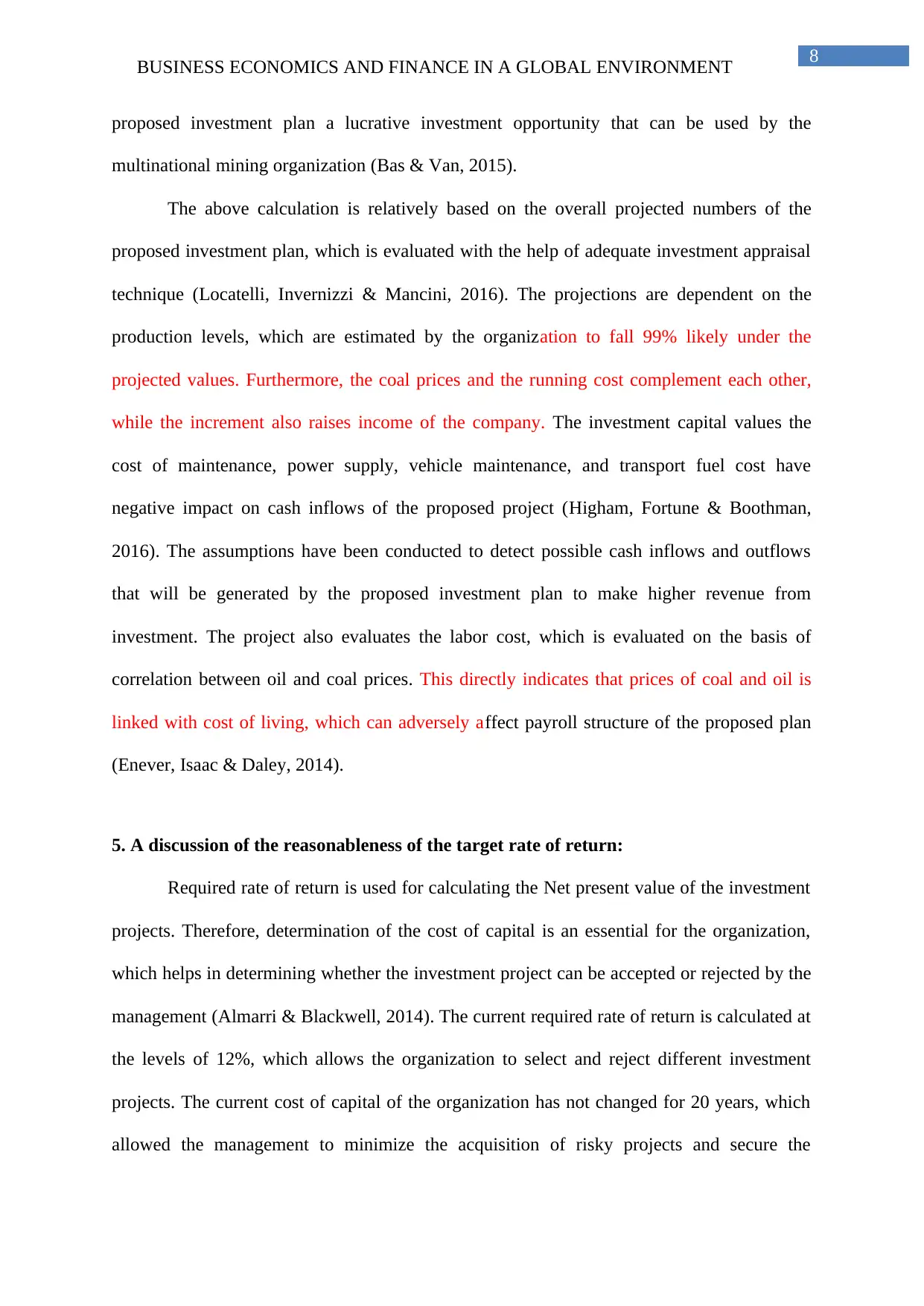
BUSINESS ECONOMICS AND FINANCE IN A GLOBAL ENVIRONMENT 8
proposed investment plan a lucrative investment opportunity that can be used by the
multinational mining organization (Bas & Van, 2015).
The above calculation is relatively based on the overall projected numbers of the
proposed investment plan, which is evaluated with the help of adequate investment appraisal
technique (Locatelli, Invernizzi & Mancini, 2016). The projections are dependent on the
production levels, which are estimated by the organization to fall 99% likely under the
projected values. Furthermore, the coal prices and the running cost complement each other,
while the increment also raises income of the company. The investment capital values the
cost of maintenance, power supply, vehicle maintenance, and transport fuel cost have
negative impact on cash inflows of the proposed project (Higham, Fortune & Boothman,
2016). The assumptions have been conducted to detect possible cash inflows and outflows
that will be generated by the proposed investment plan to make higher revenue from
investment. The project also evaluates the labor cost, which is evaluated on the basis of
correlation between oil and coal prices. This directly indicates that prices of coal and oil is
linked with cost of living, which can adversely affect payroll structure of the proposed plan
(Enever, Isaac & Daley, 2014).
5. A discussion of the reasonableness of the target rate of return:
Required rate of return is used for calculating the Net present value of the investment
projects. Therefore, determination of the cost of capital is an essential for the organization,
which helps in determining whether the investment project can be accepted or rejected by the
management (Almarri & Blackwell, 2014). The current required rate of return is calculated at
the levels of 12%, which allows the organization to select and reject different investment
projects. The current cost of capital of the organization has not changed for 20 years, which
allowed the management to minimize the acquisition of risky projects and secure the
proposed investment plan a lucrative investment opportunity that can be used by the
multinational mining organization (Bas & Van, 2015).
The above calculation is relatively based on the overall projected numbers of the
proposed investment plan, which is evaluated with the help of adequate investment appraisal
technique (Locatelli, Invernizzi & Mancini, 2016). The projections are dependent on the
production levels, which are estimated by the organization to fall 99% likely under the
projected values. Furthermore, the coal prices and the running cost complement each other,
while the increment also raises income of the company. The investment capital values the
cost of maintenance, power supply, vehicle maintenance, and transport fuel cost have
negative impact on cash inflows of the proposed project (Higham, Fortune & Boothman,
2016). The assumptions have been conducted to detect possible cash inflows and outflows
that will be generated by the proposed investment plan to make higher revenue from
investment. The project also evaluates the labor cost, which is evaluated on the basis of
correlation between oil and coal prices. This directly indicates that prices of coal and oil is
linked with cost of living, which can adversely affect payroll structure of the proposed plan
(Enever, Isaac & Daley, 2014).
5. A discussion of the reasonableness of the target rate of return:
Required rate of return is used for calculating the Net present value of the investment
projects. Therefore, determination of the cost of capital is an essential for the organization,
which helps in determining whether the investment project can be accepted or rejected by the
management (Almarri & Blackwell, 2014). The current required rate of return is calculated at
the levels of 12%, which allows the organization to select and reject different investment
projects. The current cost of capital of the organization has not changed for 20 years, which
allowed the management to minimize the acquisition of risky projects and secure the
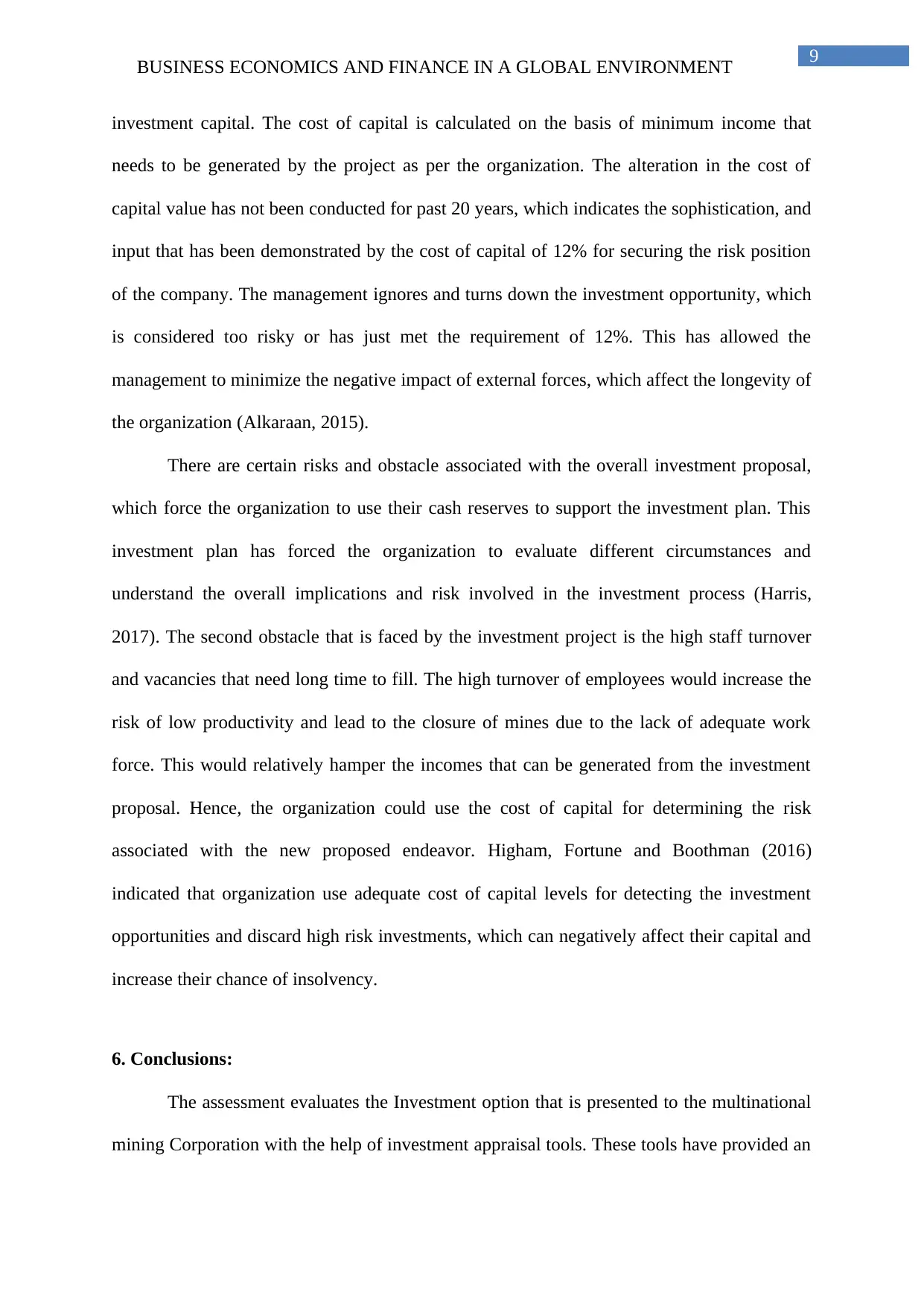
BUSINESS ECONOMICS AND FINANCE IN A GLOBAL ENVIRONMENT 9
investment capital. The cost of capital is calculated on the basis of minimum income that
needs to be generated by the project as per the organization. The alteration in the cost of
capital value has not been conducted for past 20 years, which indicates the sophistication, and
input that has been demonstrated by the cost of capital of 12% for securing the risk position
of the company. The management ignores and turns down the investment opportunity, which
is considered too risky or has just met the requirement of 12%. This has allowed the
management to minimize the negative impact of external forces, which affect the longevity of
the organization (Alkaraan, 2015).
There are certain risks and obstacle associated with the overall investment proposal,
which force the organization to use their cash reserves to support the investment plan. This
investment plan has forced the organization to evaluate different circumstances and
understand the overall implications and risk involved in the investment process (Harris,
2017). The second obstacle that is faced by the investment project is the high staff turnover
and vacancies that need long time to fill. The high turnover of employees would increase the
risk of low productivity and lead to the closure of mines due to the lack of adequate work
force. This would relatively hamper the incomes that can be generated from the investment
proposal. Hence, the organization could use the cost of capital for determining the risk
associated with the new proposed endeavor. Higham, Fortune and Boothman (2016)
indicated that organization use adequate cost of capital levels for detecting the investment
opportunities and discard high risk investments, which can negatively affect their capital and
increase their chance of insolvency.
6. Conclusions:
The assessment evaluates the Investment option that is presented to the multinational
mining Corporation with the help of investment appraisal tools. These tools have provided an
investment capital. The cost of capital is calculated on the basis of minimum income that
needs to be generated by the project as per the organization. The alteration in the cost of
capital value has not been conducted for past 20 years, which indicates the sophistication, and
input that has been demonstrated by the cost of capital of 12% for securing the risk position
of the company. The management ignores and turns down the investment opportunity, which
is considered too risky or has just met the requirement of 12%. This has allowed the
management to minimize the negative impact of external forces, which affect the longevity of
the organization (Alkaraan, 2015).
There are certain risks and obstacle associated with the overall investment proposal,
which force the organization to use their cash reserves to support the investment plan. This
investment plan has forced the organization to evaluate different circumstances and
understand the overall implications and risk involved in the investment process (Harris,
2017). The second obstacle that is faced by the investment project is the high staff turnover
and vacancies that need long time to fill. The high turnover of employees would increase the
risk of low productivity and lead to the closure of mines due to the lack of adequate work
force. This would relatively hamper the incomes that can be generated from the investment
proposal. Hence, the organization could use the cost of capital for determining the risk
associated with the new proposed endeavor. Higham, Fortune and Boothman (2016)
indicated that organization use adequate cost of capital levels for detecting the investment
opportunities and discard high risk investments, which can negatively affect their capital and
increase their chance of insolvency.
6. Conclusions:
The assessment evaluates the Investment option that is presented to the multinational
mining Corporation with the help of investment appraisal tools. These tools have provided an
⊘ This is a preview!⊘
Do you want full access?
Subscribe today to unlock all pages.

Trusted by 1+ million students worldwide
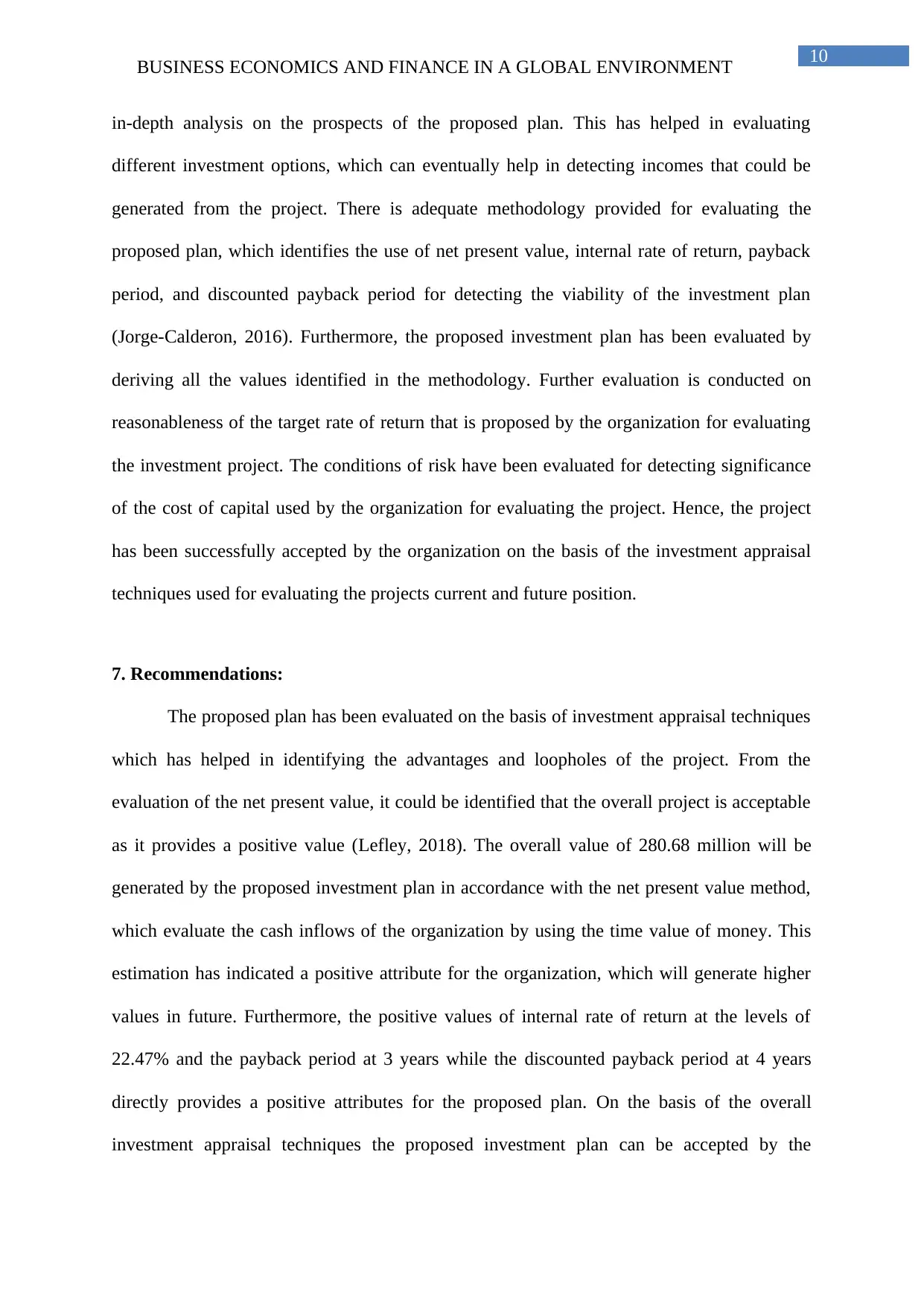
BUSINESS ECONOMICS AND FINANCE IN A GLOBAL ENVIRONMENT 10
in-depth analysis on the prospects of the proposed plan. This has helped in evaluating
different investment options, which can eventually help in detecting incomes that could be
generated from the project. There is adequate methodology provided for evaluating the
proposed plan, which identifies the use of net present value, internal rate of return, payback
period, and discounted payback period for detecting the viability of the investment plan
(Jorge-Calderon, 2016). Furthermore, the proposed investment plan has been evaluated by
deriving all the values identified in the methodology. Further evaluation is conducted on
reasonableness of the target rate of return that is proposed by the organization for evaluating
the investment project. The conditions of risk have been evaluated for detecting significance
of the cost of capital used by the organization for evaluating the project. Hence, the project
has been successfully accepted by the organization on the basis of the investment appraisal
techniques used for evaluating the projects current and future position.
7. Recommendations:
The proposed plan has been evaluated on the basis of investment appraisal techniques
which has helped in identifying the advantages and loopholes of the project. From the
evaluation of the net present value, it could be identified that the overall project is acceptable
as it provides a positive value (Lefley, 2018). The overall value of 280.68 million will be
generated by the proposed investment plan in accordance with the net present value method,
which evaluate the cash inflows of the organization by using the time value of money. This
estimation has indicated a positive attribute for the organization, which will generate higher
values in future. Furthermore, the positive values of internal rate of return at the levels of
22.47% and the payback period at 3 years while the discounted payback period at 4 years
directly provides a positive attributes for the proposed plan. On the basis of the overall
investment appraisal techniques the proposed investment plan can be accepted by the
in-depth analysis on the prospects of the proposed plan. This has helped in evaluating
different investment options, which can eventually help in detecting incomes that could be
generated from the project. There is adequate methodology provided for evaluating the
proposed plan, which identifies the use of net present value, internal rate of return, payback
period, and discounted payback period for detecting the viability of the investment plan
(Jorge-Calderon, 2016). Furthermore, the proposed investment plan has been evaluated by
deriving all the values identified in the methodology. Further evaluation is conducted on
reasonableness of the target rate of return that is proposed by the organization for evaluating
the investment project. The conditions of risk have been evaluated for detecting significance
of the cost of capital used by the organization for evaluating the project. Hence, the project
has been successfully accepted by the organization on the basis of the investment appraisal
techniques used for evaluating the projects current and future position.
7. Recommendations:
The proposed plan has been evaluated on the basis of investment appraisal techniques
which has helped in identifying the advantages and loopholes of the project. From the
evaluation of the net present value, it could be identified that the overall project is acceptable
as it provides a positive value (Lefley, 2018). The overall value of 280.68 million will be
generated by the proposed investment plan in accordance with the net present value method,
which evaluate the cash inflows of the organization by using the time value of money. This
estimation has indicated a positive attribute for the organization, which will generate higher
values in future. Furthermore, the positive values of internal rate of return at the levels of
22.47% and the payback period at 3 years while the discounted payback period at 4 years
directly provides a positive attributes for the proposed plan. On the basis of the overall
investment appraisal techniques the proposed investment plan can be accepted by the
Paraphrase This Document
Need a fresh take? Get an instant paraphrase of this document with our AI Paraphraser
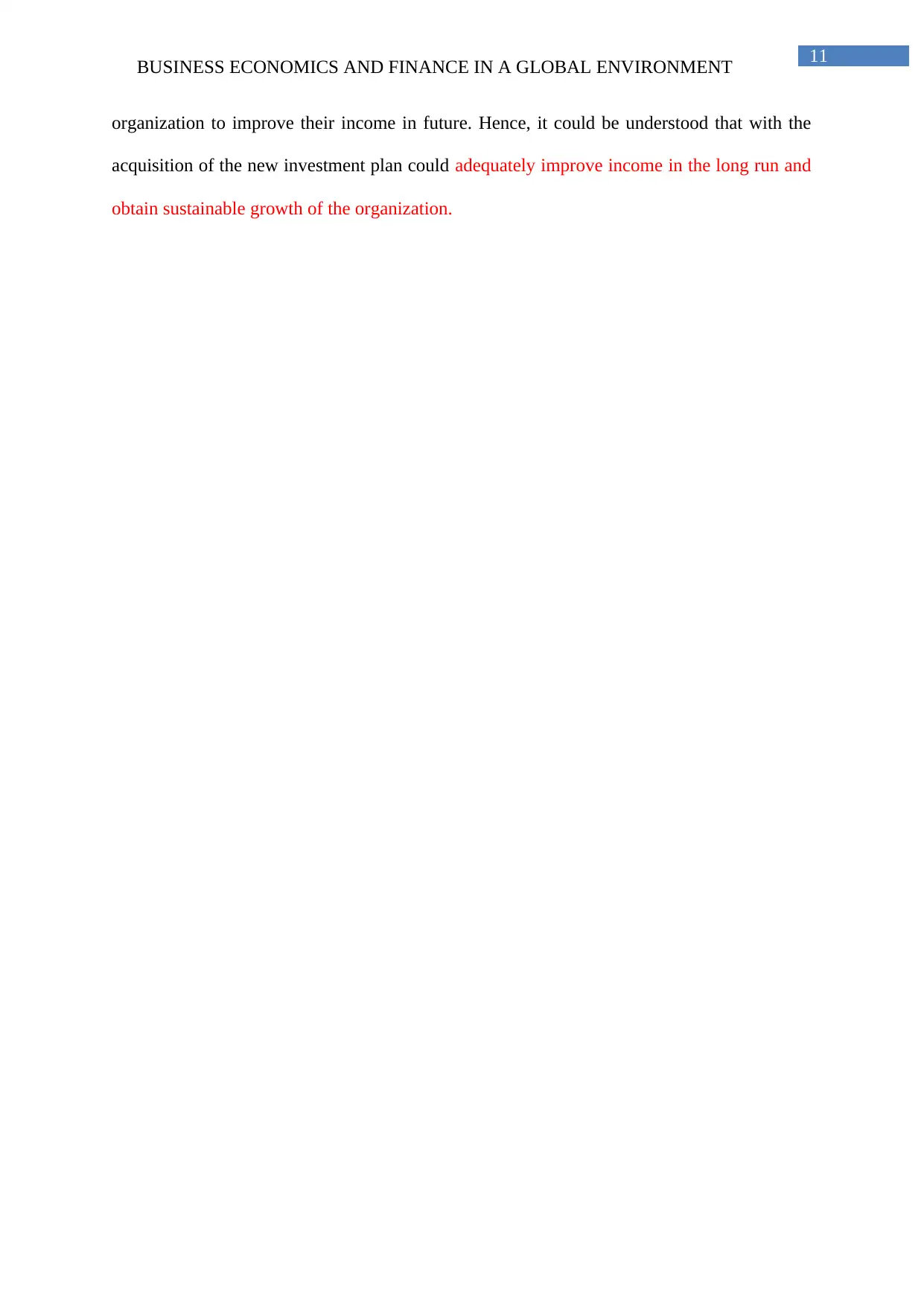
BUSINESS ECONOMICS AND FINANCE IN A GLOBAL ENVIRONMENT 11
organization to improve their income in future. Hence, it could be understood that with the
acquisition of the new investment plan could adequately improve income in the long run and
obtain sustainable growth of the organization.
organization to improve their income in future. Hence, it could be understood that with the
acquisition of the new investment plan could adequately improve income in the long run and
obtain sustainable growth of the organization.
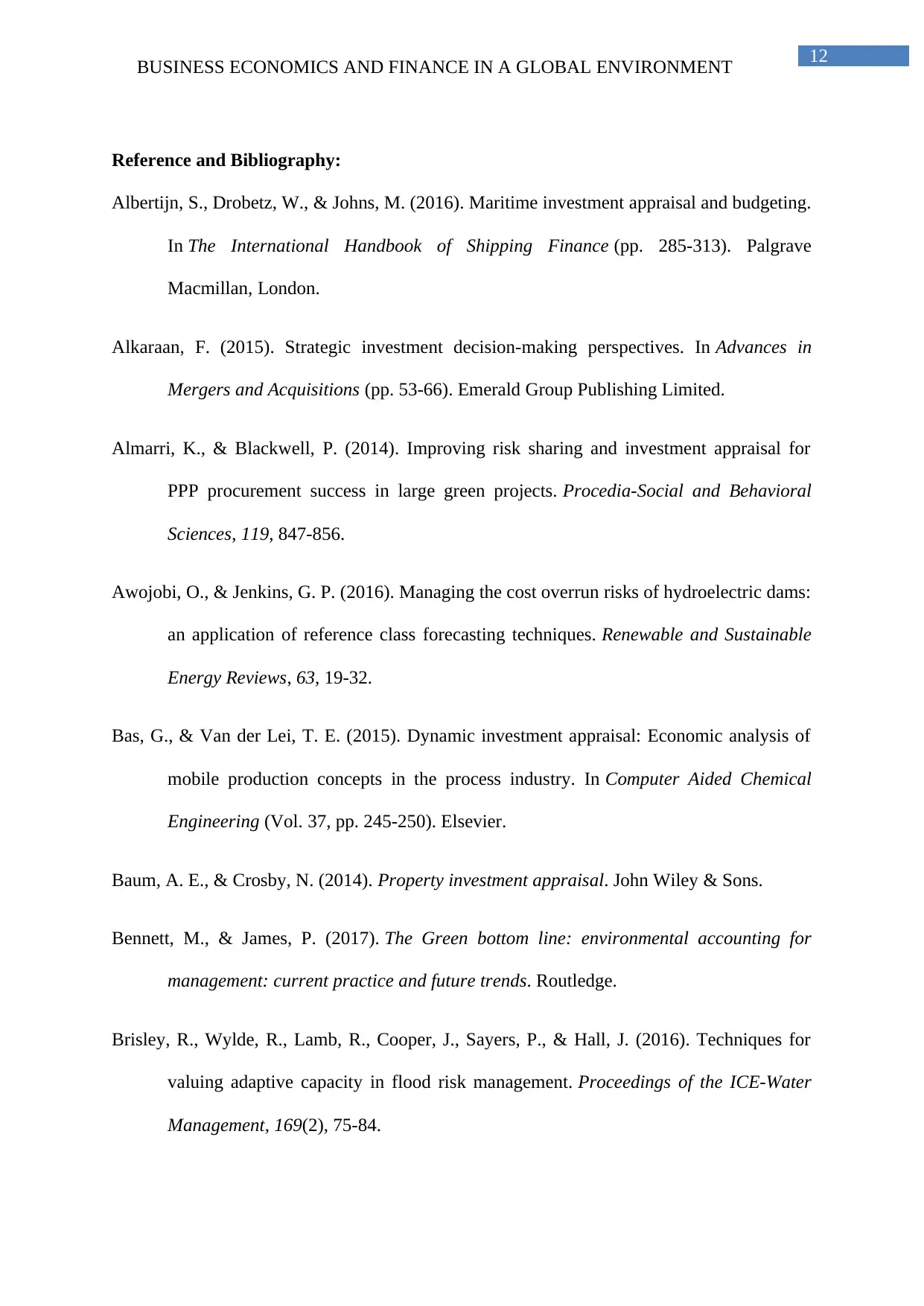
BUSINESS ECONOMICS AND FINANCE IN A GLOBAL ENVIRONMENT 12
Reference and Bibliography:
Albertijn, S., Drobetz, W., & Johns, M. (2016). Maritime investment appraisal and budgeting.
In The International Handbook of Shipping Finance (pp. 285-313). Palgrave
Macmillan, London.
Alkaraan, F. (2015). Strategic investment decision-making perspectives. In Advances in
Mergers and Acquisitions (pp. 53-66). Emerald Group Publishing Limited.
Almarri, K., & Blackwell, P. (2014). Improving risk sharing and investment appraisal for
PPP procurement success in large green projects. Procedia-Social and Behavioral
Sciences, 119, 847-856.
Awojobi, O., & Jenkins, G. P. (2016). Managing the cost overrun risks of hydroelectric dams:
an application of reference class forecasting techniques. Renewable and Sustainable
Energy Reviews, 63, 19-32.
Bas, G., & Van der Lei, T. E. (2015). Dynamic investment appraisal: Economic analysis of
mobile production concepts in the process industry. In Computer Aided Chemical
Engineering (Vol. 37, pp. 245-250). Elsevier.
Baum, A. E., & Crosby, N. (2014). Property investment appraisal. John Wiley & Sons.
Bennett, M., & James, P. (2017). The Green bottom line: environmental accounting for
management: current practice and future trends. Routledge.
Brisley, R., Wylde, R., Lamb, R., Cooper, J., Sayers, P., & Hall, J. (2016). Techniques for
valuing adaptive capacity in flood risk management. Proceedings of the ICE-Water
Management, 169(2), 75-84.
Reference and Bibliography:
Albertijn, S., Drobetz, W., & Johns, M. (2016). Maritime investment appraisal and budgeting.
In The International Handbook of Shipping Finance (pp. 285-313). Palgrave
Macmillan, London.
Alkaraan, F. (2015). Strategic investment decision-making perspectives. In Advances in
Mergers and Acquisitions (pp. 53-66). Emerald Group Publishing Limited.
Almarri, K., & Blackwell, P. (2014). Improving risk sharing and investment appraisal for
PPP procurement success in large green projects. Procedia-Social and Behavioral
Sciences, 119, 847-856.
Awojobi, O., & Jenkins, G. P. (2016). Managing the cost overrun risks of hydroelectric dams:
an application of reference class forecasting techniques. Renewable and Sustainable
Energy Reviews, 63, 19-32.
Bas, G., & Van der Lei, T. E. (2015). Dynamic investment appraisal: Economic analysis of
mobile production concepts in the process industry. In Computer Aided Chemical
Engineering (Vol. 37, pp. 245-250). Elsevier.
Baum, A. E., & Crosby, N. (2014). Property investment appraisal. John Wiley & Sons.
Bennett, M., & James, P. (2017). The Green bottom line: environmental accounting for
management: current practice and future trends. Routledge.
Brisley, R., Wylde, R., Lamb, R., Cooper, J., Sayers, P., & Hall, J. (2016). Techniques for
valuing adaptive capacity in flood risk management. Proceedings of the ICE-Water
Management, 169(2), 75-84.
⊘ This is a preview!⊘
Do you want full access?
Subscribe today to unlock all pages.

Trusted by 1+ million students worldwide
1 out of 14
Related Documents
Your All-in-One AI-Powered Toolkit for Academic Success.
+13062052269
info@desklib.com
Available 24*7 on WhatsApp / Email
![[object Object]](/_next/static/media/star-bottom.7253800d.svg)
Unlock your academic potential
Copyright © 2020–2025 A2Z Services. All Rights Reserved. Developed and managed by ZUCOL.





